Bijzondere werken van Karel Appel zoals ik ze eigenlijk nog niet eerder zag. Een eye-opener dus.
Encounter in Spring and what follows, an exhibition of work by Karel Appel (1921–2006), centring around a selection of paintings spanning from 1958 until 2006.
A founding figure of the avant-garde group CoBrA (1948–1951), Appel began his career in the aftermath of the Second World War. Over the course of six decades, the artist experimented widely, drawing on sources as diverse as folk art, outsider art and Jazz’s spirit of improvisation, and working across painting, sculpture, drawing, and stage design. Distinguishable for his astonishing capacity to innovate, Appel never settled in a signature style, media or subject. Alternating between abstraction and figuration, he adopted a material-oriented approach in his practice and promoted a genuine form of expression.
The exhibition’s starting point is the monumental and mesmeric painting Rencontre au printemps (Encounter in Spring), which was commissioned in 1958 for the inauguration of the UNESCO headquarters in Paris. To mark the occasion, UNESCO invited Appel – among luminaries including Jean Arp, Alexander Calder, Isamu Noguchi, Roberto Matta, Joan Miró, Henry Moore, and Pablo Picasso – to make a contribution. Appel painted the ambitious work, not on-site or in his Paris studio, which couldn’t accommodate its size, but in Sam Francis’ studio in Villejuif. He had, by this point, just returned from his first trip to New York for his second exhibition at Martha Jackson Gallery and was profoundly marked by his encounter with the painters of the New York School. As such, Encounter in Spring constitutes Appel’s first painting on such a momentous scale and remains one of the highlights of the UNESCO art collection.
Appel executed a sister painting, Encounter of Worlds, of the same size and year, which is in the collection of the Neue Nationalgalerie in Berlin. Key works in his oeuvre, the two paintings introduce a pictorial language that comes very close to abstraction and is animated by the same spirit of Action Painting. While they might seem a far cry from CoBrA, founded only ten years earlier in Paris, both imply, at their essence, its rallying creed for freedom and spontaneity.
As its title suggests, the sweeping abstract gestures of Encounter in Spring seem to unfurl beneath the viewer’s gaze into an abundance of forms found in nature and landscapes. Treading the threshold between impression and expression, Appel consistently associated real-world experience with what is visible on the canvas and what to a cursory glimpse might appear abstract. This liminal quality binds the works that comprise this exhibition. Viewed in chronological sequence, they reveal the overarching influence of Appel’s discovery of American painting on his first visit to the continent in 1957, and beyond. This is strikingly evident in the richly textured surface of Shattered World, 1960, with its thick impasto paint that appears to have been applied directly from the tube to the left side of the canvas, as much as the primitively rendered face which emerges from the crude brushstrokes and vibrant palette of Visage-Paysage no.4, 1977.
In the Trees series from 1979, Appel’s formerly expressive free lines and solid areas of monochrome brushwork are here substituted for simplified, nearly analytical structures made from a sequence of short parallel brush marks which converge on ascending, vertical formats. The artist had previously come cross enlarged reproductions of details from paintings by Vincent van Gogh – a discovery which paved the way for this new sense of expression, merging discipline with spontaneity. In the late ’90s, works including Up to the Sky no.3, 1998, and Birth of a Landscape, 1999, present densely animated, near-impressionist landscapes, which pulsate with thick swathes of paint. By the 2000s, Appel’s idiom had evolved once more into looser compositions of colour and form: works such as Nimble Acrobat, 2000, and Thought’s Boomerang, 2000, appear light and airy, with large swathes of raw canvas still visible, while in Evening Forest, 2003, real wood branches are embedded on the surface of the work. Brimming with creative innovation, this exhibition encapsulates the work of an artist whose imaginative and experimental approach to the painterly medium never ceased.

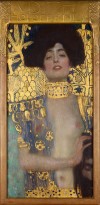
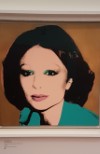
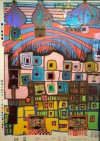

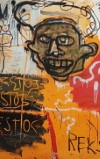
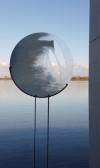
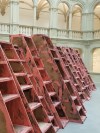 Om de expo van Andy Warhol in het Picassomuseum in Münster niet mis te lopen, trok ik op een tweede vrijdag van de maand naar de Duitse stad. Bijkomend voordeel: op die avond is de ingang van het LWL-Museum gratis. En omdat de expo van Phyllida Barlow erg klein was, vond ik dat prima. Het enorme bouwwerk in een koepel van het oude gedeelte van het museum pronkt roze in de grote ruimte. Een bezoekje waard, maar even more so doordat de vast collectie toch weer anders ingericht was dan de laatse keer dat ik hier was. Voldoende nieuws voor een mooi bezoek dus.
Om de expo van Andy Warhol in het Picassomuseum in Münster niet mis te lopen, trok ik op een tweede vrijdag van de maand naar de Duitse stad. Bijkomend voordeel: op die avond is de ingang van het LWL-Museum gratis. En omdat de expo van Phyllida Barlow erg klein was, vond ik dat prima. Het enorme bouwwerk in een koepel van het oude gedeelte van het museum pronkt roze in de grote ruimte. Een bezoekje waard, maar even more so doordat de vast collectie toch weer anders ingericht was dan de laatse keer dat ik hier was. Voldoende nieuws voor een mooi bezoek dus. Een erg fijne voorstelling van Andy Warhol in het Kunstmuseum Pablo Picasso in Münster, in Duitsland. Volgens mij wisselt het museum nogal eens van naam, maar dat doet niets af aan de altijd bijzondere expo’s die ze organiseren. De huidige, met veel grafische prints van Warhol, is erg de moeite waard. Anderhalve verdieping vol met posters van bijv. Elisabeth Taylor, Marilyn Monroe en zelfs Queen Elisabeth de Tweede. En dat is behoorlijk toevallig, nu ze net een dag of wat geleden is overleden. Blij dat ik deze expo nog mee heb kunnen pakken.
Een erg fijne voorstelling van Andy Warhol in het Kunstmuseum Pablo Picasso in Münster, in Duitsland. Volgens mij wisselt het museum nogal eens van naam, maar dat doet niets af aan de altijd bijzondere expo’s die ze organiseren. De huidige, met veel grafische prints van Warhol, is erg de moeite waard. Anderhalve verdieping vol met posters van bijv. Elisabeth Taylor, Marilyn Monroe en zelfs Queen Elisabeth de Tweede. En dat is behoorlijk toevallig, nu ze net een dag of wat geleden is overleden. Blij dat ik deze expo nog mee heb kunnen pakken.
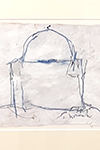 Bij een bezoek aan het Osthaus Museum Hagen ontdekte ik dat in hetzelfde gebouw aan de overkant van de hal het Emil Schumacher Museum gevestigd is. Na een wat vage ruimte waar gebruiksartikelen gecombineerd werden met Schumacher’s werken, kwam ik in een zaal waar ik erg enthousiast van werd, namelijk met werken uit respectievelijk Tunesië, Egypte en Marokko. En die waren verrassend mooi. Eenvoudig en sereen. Een mooie toevallige vondst dus!
Bij een bezoek aan het Osthaus Museum Hagen ontdekte ik dat in hetzelfde gebouw aan de overkant van de hal het Emil Schumacher Museum gevestigd is. Na een wat vage ruimte waar gebruiksartikelen gecombineerd werden met Schumacher’s werken, kwam ik in een zaal waar ik erg enthousiast van werd, namelijk met werken uit respectievelijk Tunesië, Egypte en Marokko. En die waren verrassend mooi. Eenvoudig en sereen. Een mooie toevallige vondst dus!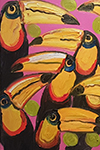 Door een poster merkte ik op dat ik één deel van het Osthaus Museum Hagen compleet gemist had. Ik werd door een suppoost naar het betreffende gedeelte geleid en daar hingen een flink aantal kleurrijke neo-expressionistische werken van Hunt Slonem. Een artiest die ik nog niet kende, met veelal dieren in de hoofdrol, zoals deze toekans maar ook andere vogels en konijntjes. Qua kleur doen de werken me sterk denken aan de werken van Chinees-Amerikaanse Wallase Ting, die begin jaren ’90 indruk op me maakten, toen de schilder in Amsterdam kwam wonen. Interessante expo.
Door een poster merkte ik op dat ik één deel van het Osthaus Museum Hagen compleet gemist had. Ik werd door een suppoost naar het betreffende gedeelte geleid en daar hingen een flink aantal kleurrijke neo-expressionistische werken van Hunt Slonem. Een artiest die ik nog niet kende, met veelal dieren in de hoofdrol, zoals deze toekans maar ook andere vogels en konijntjes. Qua kleur doen de werken me sterk denken aan de werken van Chinees-Amerikaanse Wallase Ting, die begin jaren ’90 indruk op me maakten, toen de schilder in Amsterdam kwam wonen. Interessante expo. Om zeven uur vanochtend liep ik al street art te spotten in Düsseldorf. Het leek me een mooie afwisseling om na de stadse omgeving, ook het Museum Instel Hombroich in Neuss (naast Düsseldorf) te bezoeken. Hoe ‘natuurlijk’ die omgeving was, had ik onderschat. Het Museum Instel Hombroich is meer een park waarin natuur afwisselt met sculpturen, bijzondere bouwwerken van met name Erwin Heerich en kunst. Vanwege de vakantieperiode waren een aantal kunstruimten gesloten, maar de ruimte waar ik voor kwam, de Schnecke, was wel open. Het museum geeft zelf aan werken te hebben van Hans Arp, Constantin Brancusi, Marcel Breuer, Alexander Calder, Paul Cézanne, Eduardo Chillida, Lovis Corinth, Jean Fautrier, Alberto Giacometti, Gotthard Graubner, Raymond Hains, Erwin Heerich, Anatol Herzfeld, Alfred Jensen, Yves Klein, Gustav Klimt, Norbert Kricke, Oliver Kruse, Henri Matisse, Francis Picabia, Rembrandt, Gerrit Rietveld, Medardo Rosso, Fritz Schwegler, Kurt Schwitters, Norbert Tadeusz, Bart van der Leck maar let me tell you, dat was wel een speurtocht. Niet alleen is het terrein erg slecht bewegwijzerd, ook de werken hebben geen bordjes dus is het raden welk werk van welke kunstenaar is. Desalniettemin een uitstapje dat de moeite meer dan waard is, alleen adviseer ik dat niet bij >32 graden te doen.
Om zeven uur vanochtend liep ik al street art te spotten in Düsseldorf. Het leek me een mooie afwisseling om na de stadse omgeving, ook het Museum Instel Hombroich in Neuss (naast Düsseldorf) te bezoeken. Hoe ‘natuurlijk’ die omgeving was, had ik onderschat. Het Museum Instel Hombroich is meer een park waarin natuur afwisselt met sculpturen, bijzondere bouwwerken van met name Erwin Heerich en kunst. Vanwege de vakantieperiode waren een aantal kunstruimten gesloten, maar de ruimte waar ik voor kwam, de Schnecke, was wel open. Het museum geeft zelf aan werken te hebben van Hans Arp, Constantin Brancusi, Marcel Breuer, Alexander Calder, Paul Cézanne, Eduardo Chillida, Lovis Corinth, Jean Fautrier, Alberto Giacometti, Gotthard Graubner, Raymond Hains, Erwin Heerich, Anatol Herzfeld, Alfred Jensen, Yves Klein, Gustav Klimt, Norbert Kricke, Oliver Kruse, Henri Matisse, Francis Picabia, Rembrandt, Gerrit Rietveld, Medardo Rosso, Fritz Schwegler, Kurt Schwitters, Norbert Tadeusz, Bart van der Leck maar let me tell you, dat was wel een speurtocht. Niet alleen is het terrein erg slecht bewegwijzerd, ook de werken hebben geen bordjes dus is het raden welk werk van welke kunstenaar is. Desalniettemin een uitstapje dat de moeite meer dan waard is, alleen adviseer ik dat niet bij >32 graden te doen.